traction control BMW ACTIVE HYBRID 3 2014 F30H User Guide
[x] Cancel search | Manufacturer: BMW, Model Year: 2014, Model line: ACTIVE HYBRID 3, Model: BMW ACTIVE HYBRID 3 2014 F30HPages: 247, PDF Size: 6.04 MB
Page 130 of 247
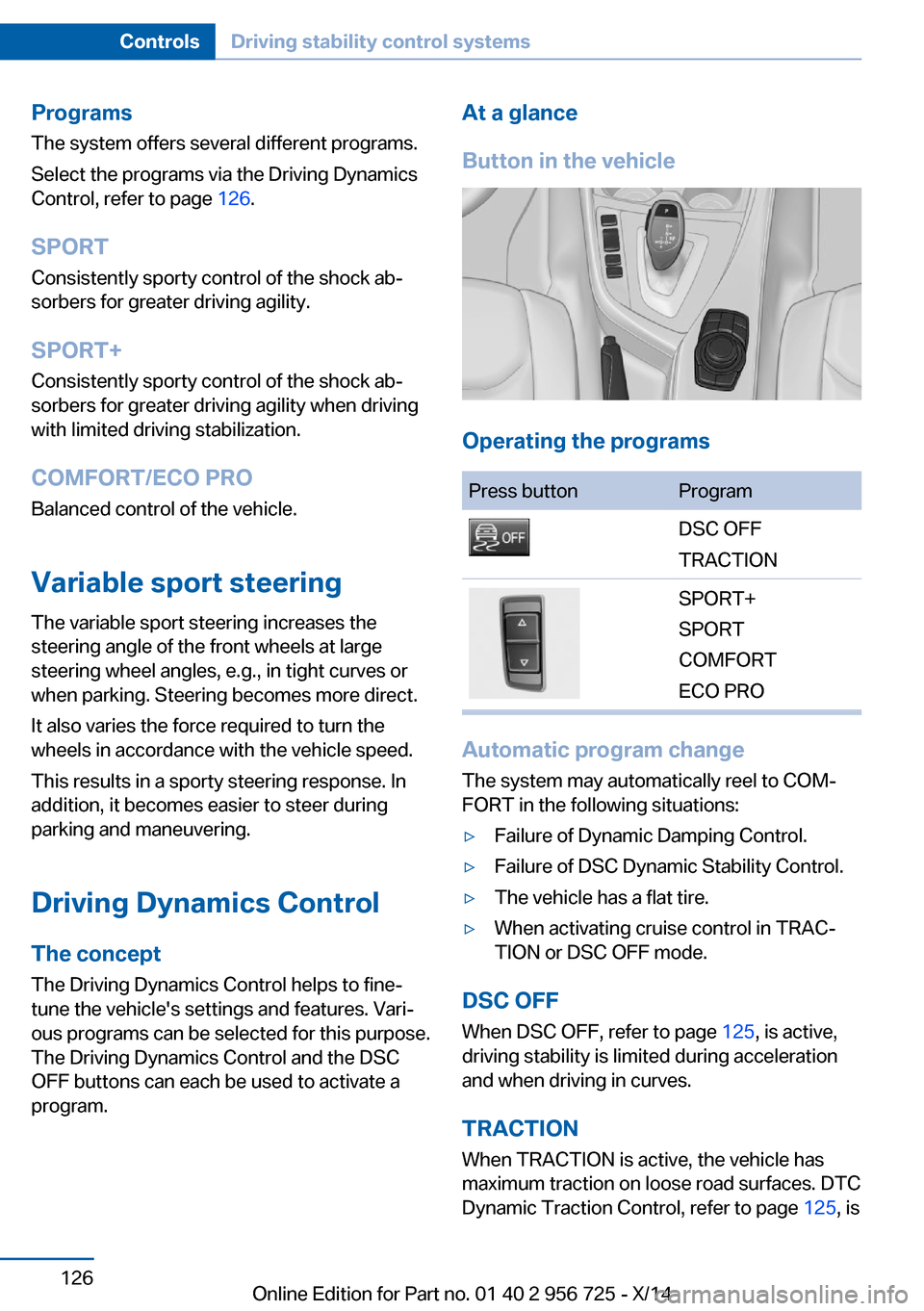
ProgramsThe system offers several different programs.
Select the programs via the Driving Dynamics
Control, refer to page 126.
SPORT Consistently sporty control of the shock ab‐
sorbers for greater driving agility.
SPORT+
Consistently sporty control of the shock ab‐
sorbers for greater driving agility when driving
with limited driving stabilization.
COMFORT/ECO PRO Balanced control of the vehicle.
Variable sport steering The variable sport steering increases the
steering angle of the front wheels at large
steering wheel angles, e.g., in tight curves or
when parking. Steering becomes more direct.
It also varies the force required to turn the
wheels in accordance with the vehicle speed.
This results in a sporty steering response. In
addition, it becomes easier to steer during
parking and maneuvering.
Driving Dynamics Control The conceptThe Driving Dynamics Control helps to fine-
tune the vehicle's settings and features. Vari‐
ous programs can be selected for this purpose.
The Driving Dynamics Control and the DSC
OFF buttons can each be used to activate a
program.At a glance
Button in the vehicle
Operating the programs
Press buttonProgramDSC OFF
TRACTIONSPORT+
SPORT
COMFORT
ECO PRO
Automatic program change
The system may automatically reel to COM‐
FORT in the following situations:
▷Failure of Dynamic Damping Control.▷Failure of DSC Dynamic Stability Control.▷The vehicle has a flat tire.▷When activating cruise control in TRAC‐
TION or DSC OFF mode.
DSC OFF
When DSC OFF, refer to page 125, is active,
driving stability is limited during acceleration
and when driving in curves.
TRACTION When TRACTION is active, the vehicle has
maximum traction on loose road surfaces. DTC
Dynamic Traction Control, refer to page 125, is
Seite 126ControlsDriving stability control systems126
Online Edition for Part no. 01 40 2 956 725 - X/14
Page 131 of 247
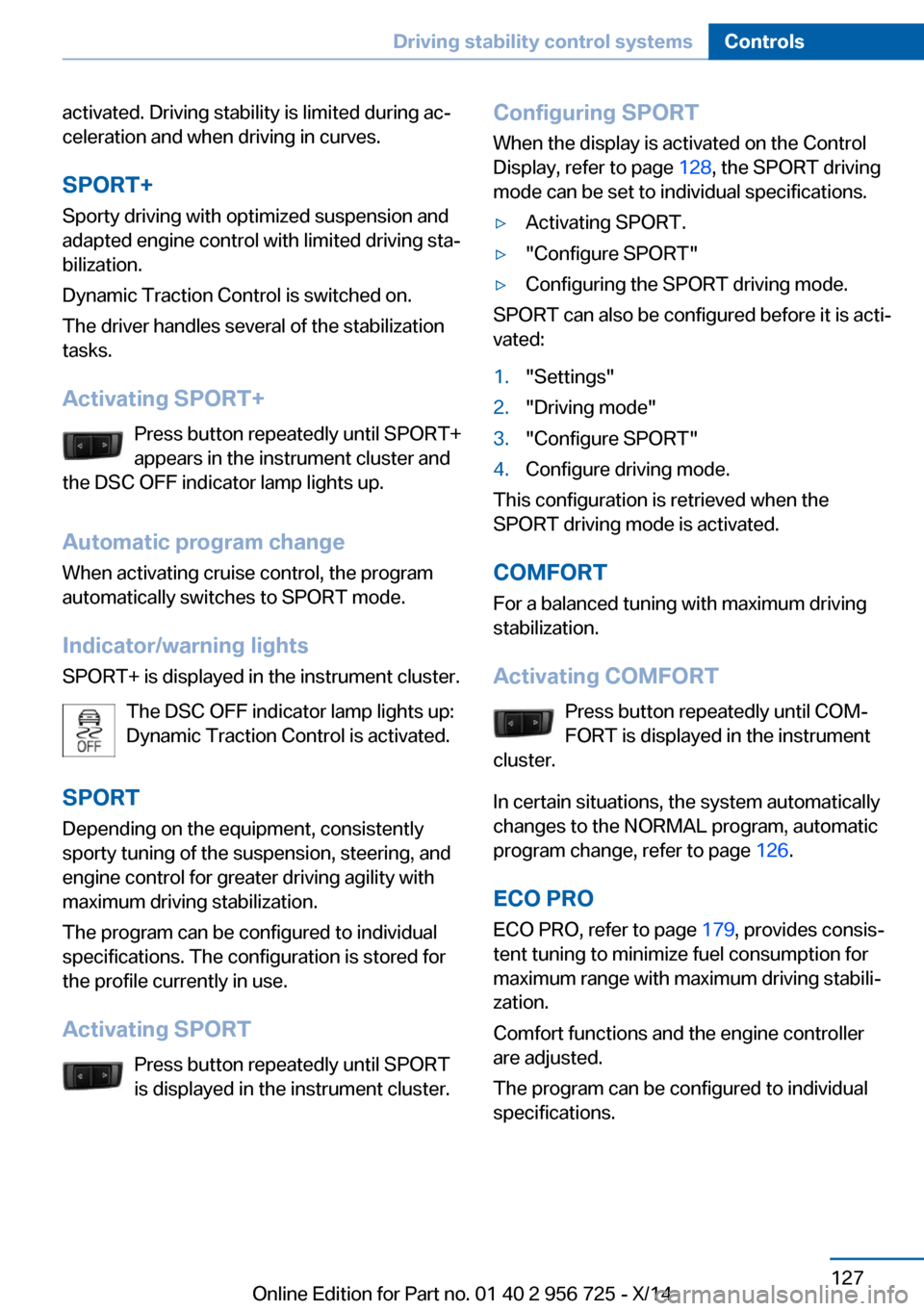
activated. Driving stability is limited during ac‐
celeration and when driving in curves.
SPORT+
Sporty driving with optimized suspension and
adapted engine control with limited driving sta‐
bilization.
Dynamic Traction Control is switched on.
The driver handles several of the stabilization
tasks.
Activating SPORT+ Press button repeatedly until SPORT+
appears in the instrument cluster and
the DSC OFF indicator lamp lights up.
Automatic program change When activating cruise control, the program
automatically switches to SPORT mode.
Indicator/warning lights
SPORT+ is displayed in the instrument cluster.
The DSC OFF indicator lamp lights up:
Dynamic Traction Control is activated.
SPORT Depending on the equipment, consistently
sporty tuning of the suspension, steering, and
engine control for greater driving agility with
maximum driving stabilization.
The program can be configured to individual
specifications. The configuration is stored for
the profile currently in use.
Activating SPORT Press button repeatedly until SPORT
is displayed in the instrument cluster.Configuring SPORT
When the display is activated on the Control
Display, refer to page 128, the SPORT driving
mode can be set to individual specifications.▷Activating SPORT.▷"Configure SPORT"▷Configuring the SPORT driving mode.
SPORT can also be configured before it is acti‐
vated:
1."Settings"2."Driving mode"3."Configure SPORT"4.Configure driving mode.
This configuration is retrieved when the
SPORT driving mode is activated.
COMFORT For a balanced tuning with maximum driving
stabilization.
Activating COMFORT Press button repeatedly until COM‐
FORT is displayed in the instrument
cluster.
In certain situations, the system automatically
changes to the NORMAL program, automatic
program change, refer to page 126.
ECO PRO ECO PRO, refer to page 179, provides consis‐
tent tuning to minimize fuel consumption for
maximum range with maximum driving stabili‐
zation.
Comfort functions and the engine controller
are adjusted.
The program can be configured to individual
specifications.
Seite 127Driving stability control systemsControls127
Online Edition for Part no. 01 40 2 956 725 - X/14
Page 135 of 247

InterruptingWhen active, press the button.
If interrupting the system while stationary,
press on the brake pedal at the same time.
The system is automatically interrupted in the
following situations:▷When the brakes are applied.▷When drive mode D is removed.▷When DTC Dynamic Traction Control is
activated or DSC is deactivated.▷When DSC is actively controlling stability.▷When SPORT+ is activated with Driving
Dynamics Control.▷If the safety belt and the driver's door are
opened while the vehicle is standing still.▷If the system has not detected objects for
an extended period, e.g., on a road with
very little traffic without curb or shoulder
markings.▷If the detection range of the radar is dis‐
rupted, e.g., by dirt or heavy fog.
Maintaining, storing, and changing the
speed
Hints Adjusting the desired speedModify desired speed to road conditions
and be ready to brake at all times; otherwise,
there is the risk of an accident.◀
Differences in speed
Large differences in speed relative to ve‐
hicles ahead of the vehicle cannot be compen‐
sated by the system for example in the follow‐
ing situations:
▷When fast approaching a slowly moving
vehicle.▷When another vehicle suddenly swerves
into the wrong lane.◀Maintaining/storing the speed
Press button.
Or:
Press the rocker reel while the system is inter‐
rupted.
When the system is switched on, the current
speed is maintained and stored as the desired
speed.
This is displayed in the speedometer and
briefly in the instrument cluster. Displays in the
instrument cluster, refer to page 132.
When cruise control is maintained or stored,
DSC Dynamic Stability Control will be turned
on if needed.
Changing the speed
Press the rocker reel up or down repeatedly
until the desired speed is set.
If active, the displayed speed is stored and the vehicle reaches the stored speed when the
road is clear.
▷Each time the rocker reel is pressed to the
point of resistance, the desired speed in‐
creases or decreases by approx.
1 mph/1 km/h.▷Each time the rocker reel is pressed past
the point of resistance, the desired speed
increases or decreases by a maximum of
5 mph/10 km/h.
Hold the rocker reel in position to repeat the
action.
Seite 131Driving comfortControls131
Online Edition for Part no. 01 40 2 956 725 - X/14
Page 140 of 247
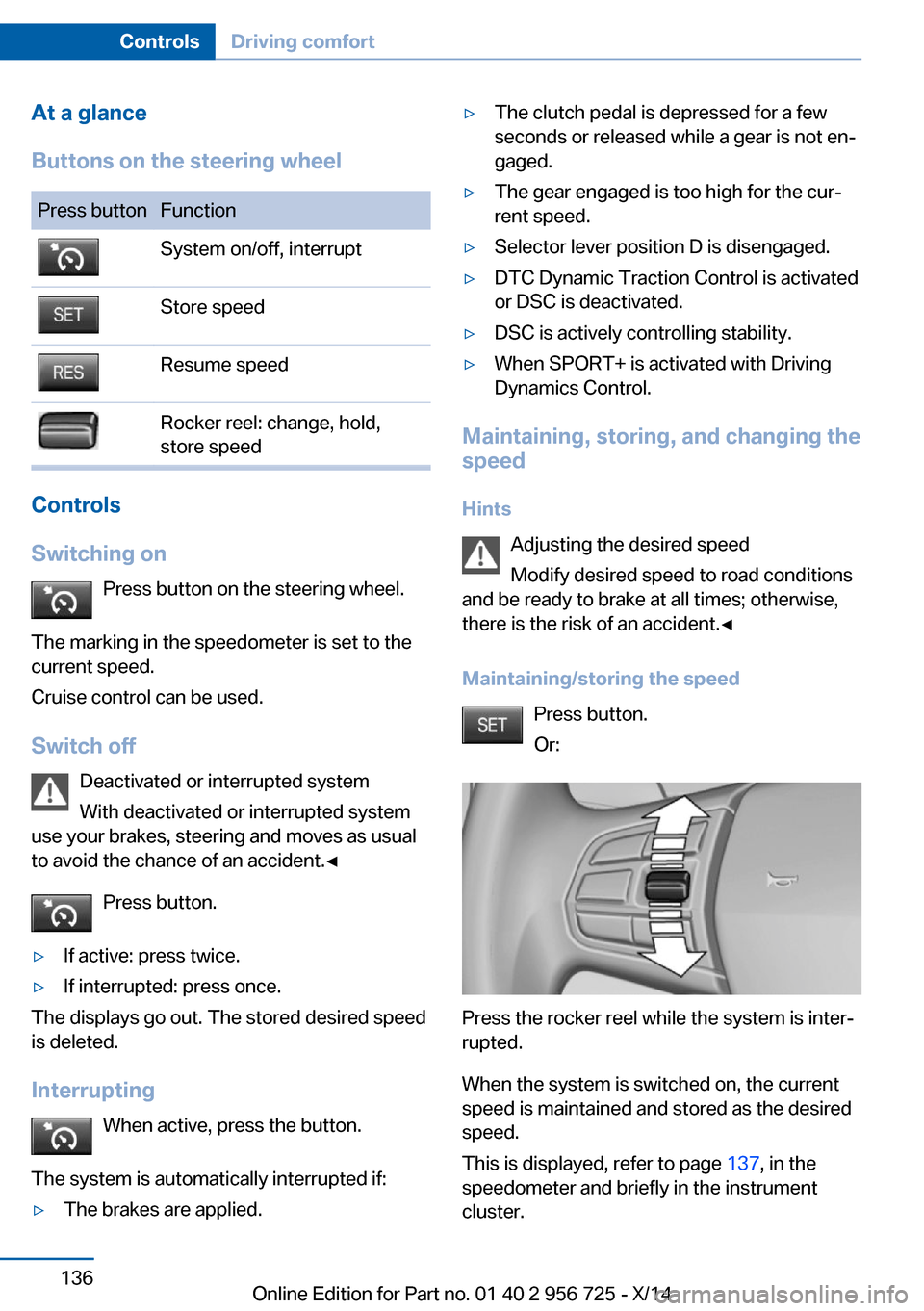
At a glance
Buttons on the steering wheelPress buttonFunctionSystem on/off, interruptStore speedResume speedRocker reel: change, hold,
store speed
Controls
Switching on Press button on the steering wheel.
The marking in the speedometer is set to the
current speed.
Cruise control can be used.
Switch off Deactivated or interrupted system
With deactivated or interrupted system
use your brakes, steering and moves as usual
to avoid the chance of an accident.◀
Press button.
▷If active: press twice.▷If interrupted: press once.
The displays go out. The stored desired speed
is deleted.
Interrupting When active, press the button.
The system is automatically interrupted if:
▷The brakes are applied.▷The clutch pedal is depressed for a few
seconds or released while a gear is not en‐
gaged.▷The gear engaged is too high for the cur‐
rent speed.▷Selector lever position D is disengaged.▷DTC Dynamic Traction Control is activated
or DSC is deactivated.▷DSC is actively controlling stability.▷When SPORT+ is activated with Driving
Dynamics Control.
Maintaining, storing, and changing the
speed
Hints Adjusting the desired speed
Modify desired speed to road conditions
and be ready to brake at all times; otherwise,
there is the risk of an accident.◀
Maintaining/storing the speed Press button.
Or:
Press the rocker reel while the system is inter‐
rupted.
When the system is switched on, the current
speed is maintained and stored as the desired
speed.
This is displayed, refer to page 137, in the
speedometer and briefly in the instrument
cluster.
Seite 136ControlsDriving comfort136
Online Edition for Part no. 01 40 2 956 725 - X/14
Page 197 of 247

Y: speed rating, before the R on ZR tiresSpeed letter
Q = up to 100 mph, 160 km/h
R = up to 106 mph, 170 km/h
S = up to 112 mph, 180 km/h
T = up to 118 mph, 190 km/h
H = up to 131 mph, 210 km/h
V = up to 150 mph, 240 km/h
W = up to 167 mph, 270 km/h
Y = up to 186 mph, 300 km/h
Tire Identification NumberDOT code: DOT xxxx xxx 4314
xxxx: manufacturer code for the tire brand
xxx: tire size and tire design
4314: tire age
Tires with DOT codes meet the guidelines of
the U.S. Department of Transportation.
Tire age DOT … 4314: the tire was manufactured in the
43th week of 2014.
Recommendation
Regardless of wear and tear, replace tires at
least every 6 years.
Uniform Tire Quality Grading
Quality grades can be found where applicable
on the tire sidewall between tread shoulder
and maximum section width.
For example: Treadwear 200; Traction AA;
Temperature A
DOT Quality Grades Treadwear
Traction AA A B C
Temperature A B CAll passenger car tires must conform to Fed‐
eral Safety Requirements in addition to these
grades.
Treadwear
The treadwear grade is a comparative rating
based on the wear rate of the tire when tested
under controlled conditions on a specified gov‐
ernment test course. For example, a tire
graded 150 would wear one and one-half, 1 g,
times as well on the government course as a
tire graded 100. The relative performance of
tires depends upon the actual conditions of
their use, however, and may depart signifi‐
cantly from the norm due to variations in driv‐
ing habits, service practices and differences in
road characteristics and climate.
Traction
The traction grades, from highest to lowest,
are AA, A, B, and C.
Those grades represent the tire's ability to
stop on wet pavement as measured under
controlled conditions on specified government
test surfaces of asphalt and concrete. A tire
marked C may have poor traction performance.
The traction grade assigned to this tire is
based on straight-ahead braking traction tests,
and does not include acceleration, cornering,
hydroplaning, or peak traction characteristics.
Temperature The temperature grades are A, the highest, B,
and C, representing the tire's resistance to the
generation of heat and its ability to dissipate
heat when tested under controlled conditions
on a specified indoor laboratory test wheel.
Sustained high temperature can cause the ma‐
terial of the tire to degenerate and reduce tire
life, and excessive temperature can lead to
sudden tire failure. The grade C corresponds
to a level of performance which all passenger
car tires must meet under the Federal Motor
Vehicle Safety Standard No. 109. Grades Band
A represent higher levels of performance onSeite 193Wheels and tiresMobility193
Online Edition for Part no. 01 40 2 956 725 - X/14
Page 201 of 247
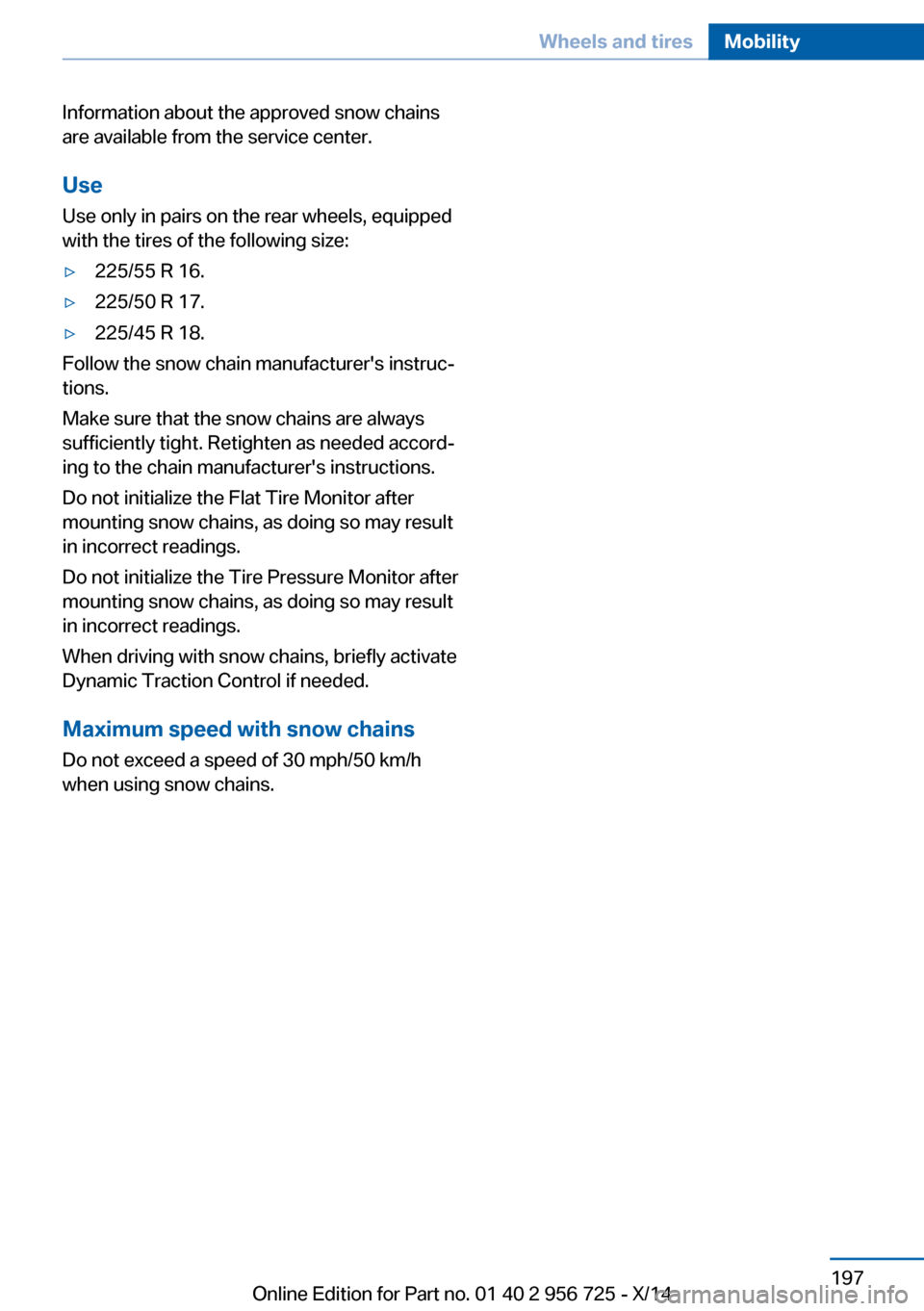
Information about the approved snow chains
are available from the service center.
Use
Use only in pairs on the rear wheels, equipped
with the tires of the following size:▷225/55 R 16.▷225/50 R 17.▷225/45 R 18.
Follow the snow chain manufacturer's instruc‐
tions.
Make sure that the snow chains are always
sufficiently tight. Retighten as needed accord‐
ing to the chain manufacturer's instructions.
Do not initialize the Flat Tire Monitor after
mounting snow chains, as doing so may result
in incorrect readings.
Do not initialize the Tire Pressure Monitor after
mounting snow chains, as doing so may result
in incorrect readings.
When driving with snow chains, briefly activate
Dynamic Traction Control if needed.
Maximum speed with snow chains Do not exceed a speed of 30 mph/50 km/hwhen using snow chains.
Seite 197Wheels and tiresMobility197
Online Edition for Part no. 01 40 2 956 725 - X/14
Page 238 of 247
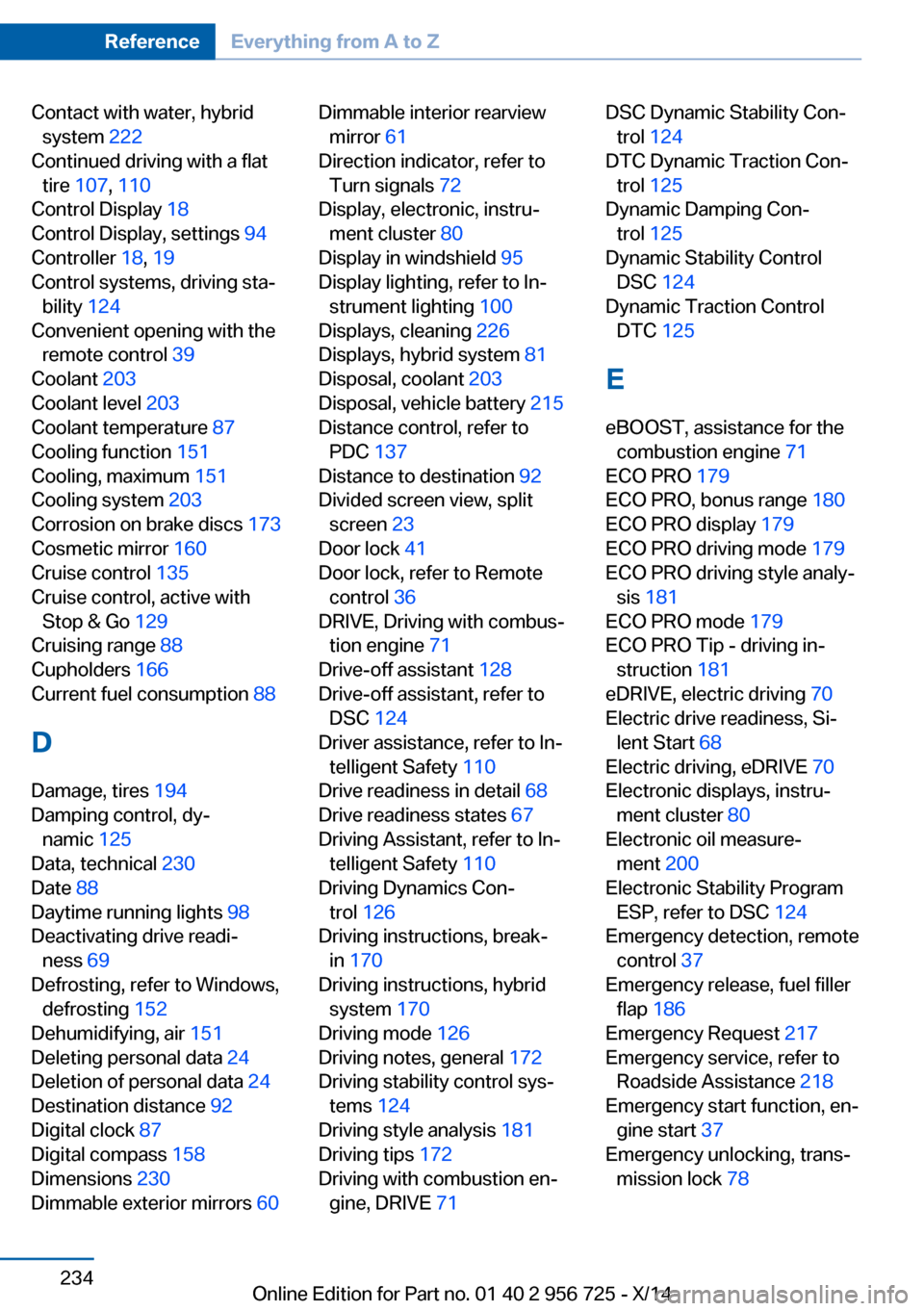
Contact with water, hybridsystem 222
Continued driving with a flat tire 107 , 110
Control Display 18
Control Display, settings 94
Controller 18, 19
Control systems, driving sta‐ bility 124
Convenient opening with the remote control 39
Coolant 203
Coolant level 203
Coolant temperature 87
Cooling function 151
Cooling, maximum 151
Cooling system 203
Corrosion on brake discs 173
Cosmetic mirror 160
Cruise control 135
Cruise control, active with Stop & Go 129
Cruising range 88
Cupholders 166
Current fuel consumption 88
D
Damage, tires 194
Damping control, dy‐ namic 125
Data, technical 230
Date 88
Daytime running lights 98
Deactivating drive readi‐ ness 69
Defrosting, refer to Windows, defrosting 152
Dehumidifying, air 151
Deleting personal data 24
Deletion of personal data 24
Destination distance 92
Digital clock 87
Digital compass 158
Dimensions 230
Dimmable exterior mirrors 60 Dimmable interior rearview
mirror 61
Direction indicator, refer to Turn signals 72
Display, electronic, instru‐ ment cluster 80
Display in windshield 95
Display lighting, refer to In‐ strument lighting 100
Displays, cleaning 226
Displays, hybrid system 81
Disposal, coolant 203
Disposal, vehicle battery 215
Distance control, refer to PDC 137
Distance to destination 92
Divided screen view, split screen 23
Door lock 41
Door lock, refer to Remote control 36
DRIVE, Driving with combus‐ tion engine 71
Drive-off assistant 128
Drive-off assistant, refer to DSC 124
Driver assistance, refer to In‐ telligent Safety 110
Drive readiness in detail 68
Drive readiness states 67
Driving Assistant, refer to In‐ telligent Safety 110
Driving Dynamics Con‐ trol 126
Driving instructions, break- in 170
Driving instructions, hybrid system 170
Driving mode 126
Driving notes, general 172
Driving stability control sys‐ tems 124
Driving style analysis 181
Driving tips 172
Driving with combustion en‐ gine, DRIVE 71 DSC Dynamic Stability Con‐
trol 124
DTC Dynamic Traction Con‐ trol 125
Dynamic Damping Con‐ trol 125
Dynamic Stability Control DSC 124
Dynamic Traction Control DTC 125
E eBOOST, assistance for the combustion engine 71
ECO PRO 179
ECO PRO, bonus range 180
ECO PRO display 179
ECO PRO driving mode 179
ECO PRO driving style analy‐ sis 181
ECO PRO mode 179
ECO PRO Tip - driving in‐ struction 181
eDRIVE, electric driving 70
Electric drive readiness, Si‐ lent Start 68
Electric driving, eDRIVE 70
Electronic displays, instru‐ ment cluster 80
Electronic oil measure‐ ment 200
Electronic Stability Program ESP, refer to DSC 124
Emergency detection, remote control 37
Emergency release, fuel filler flap 186
Emergency Request 217
Emergency service, refer to Roadside Assistance 218
Emergency start function, en‐ gine start 37
Emergency unlocking, trans‐ mission lock 78 Seite 234ReferenceEverything from A to Z234
Online Edition for Part no. 01 40 2 956 725 - X/14
Page 244 of 247

Text message, supplemen‐tary 86
Theft alarm system, refer to Alarm system 46
Thigh support 54
Through-loading system 162
Tilt alarm sensor 47
Time of arrival 92
Tire damage 194
Tire identification marks 192
Tire inflation pressure 190
Tire inflation pressure moni‐ tor, refer to FTM 109
Tire Pressure Monitor TPM 105
Tires, changing 195
Tires, everything on wheels and tires 190
Tires, run-flat tires 196
Tire tread 194
Tone, see user's manual for Navigation, Entertainment
and Communication
Tool 206
Top View 143
Total vehicle weight 231
Touchpad 21
Tow fitting 221
Towing 220
Tow lug, see tow fitting 221
Tow-starting 220
TPM Tire Pressure Moni‐ tor 105
Traction control 125
TRACTION, driving dynam‐ ics 125
Transmission lock, electronic unlocking 78
Transmission, Steptronic transmission 76
Transporting children safely 62
Tread, tires 194
Trip computer 92
Triple turn signal activa‐ tion 72 Trip odometer 87
Trunk lid closing 42
Trunk lid, emergency unlock‐ ing 43
Trunk lid, hotel function 42
Trunk lid opening 42
Trunk lid, opening with no- touch activation 44
Trunk lid via remote con‐ trol 40
Turning circle 230
Turning circle lines, rearview camera 141
Turn signals, operation 72
U Unintentional alarm 47
Units of measure 95
Universal remote control 156
Unlock button, Steptronic transmission 76
Unlocking/locking via door lock 41
Unlocking/locking with re‐ mote control 39
Unlocking, settings 45
Updates made after the edito‐ rial deadline 7
Upholstery care 225
USB interface 161
V Vanity mirror 160
Variable sport steering 126
Vehicle battery 215
Vehicle battery, replac‐ ing 215
Vehicle, break-in 170
Vehicle care 224
Vehicle features and op‐ tions 6
Vehicle identification num‐ ber 10
Vehicle jack 214 Vehicle paint 224
Vehicle storage 226
Vehicle wash 223
Ventilation 153
Ventilation, refer to Parked- car ventilation 153
VIN, see vehicle identification number 10
Voice activation system 26
W Warning and indicator lamps, see Check Control 83
Warning displays, see Check Control 83
Warning messages, see Check Control 83
Warning triangle 218
Washer fluid 75
Washer nozzles, wind‐ shield 74
Washer system 73
Washing, vehicle 223
Water, hybrid system 222
Water on roads 173
Weights 231
Welcome lights 97
What to do after an acci‐ dent 222
Wheel base, vehicle 230
Wheel cleaner 225
Wheels, changing 195
Wheels, everything on wheels and tires 190
Wheels, Flat Tire Monitor FTM 109
Wheels, Tire Pressure Moni‐ tor TPM 105
Width, vehicle 230
Window defroster, rear 152
Windows, powered 48
Windshield washer fluid 75
Windshield washer noz‐ zles 74 Seite 240ReferenceEverything from A to Z240
Online Edition for Part no. 01 40 2 956 725 - X/14